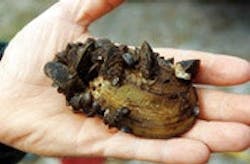Invasive Mussels Focus of Workshop for Water-Supply Professionals
Methods to control the spread of nonnative mussels in U.S. drinking water infrastructures were the topic of a recent workshop for water-supply professionals, co-sponsored by the Awwa Research Foundation (AwwaRF), Southern Nevada Water Authority and Metropolitan Water District of Southern California.
AwwaRF funding for the workshop was made available through its Rapid Response Research Program, which provides a fast-track research response to urgent, immediate, or unforeseen research needs of the drinking water community.
Quagga and zebra mussels, invasive and potentially costly aquatic species, have infiltrated U.S. waterways since the late 1980s. The mussels proliferate rapidly, disrupting natural food chains, clogging water intakes and fostering the growth of algae in water supplies.
The purpose of the two-day workshop, which was held in April in Las Vegas, was to explore effective strategies that water suppliers can use to control quagga and zebra mussel populations in the southwestern U.S. and manage the infrastructure that they threaten. The 140 workshop attendees exchanged ideas and technical approaches, and discussed priorities for future research on the issues involved.
“Quagga and zebra mussels pose a threat to public drinking water supplies because of their potential to invade and colonize water systems,” said Robert C. Renner, AwwaRF executive director. “Mussel infestations can clog the intakes and raw water conveyance systems of water utilities. Mussels can also negatively impact lakes and rivers by altering or destroying the ecology of fish habitats, reducing recreational and aesthetic value and making lakes more susceptible to problematic algae blooms.”
At the workshop, several invited experts with experience in the fields of mussel treatment and control, water system protection and natural water ecosystem protection addressed attendees. Specific topics of discussion included control and disinfection, reproductive patterns, population behavior, population tracking and monitoring methods, chemical inactivation and barriers and population management. Through a collaborative exercise, workshop participants identified areas where further research is needed to understand mussel lifecycles in the west and to further test and develop control methods for managing large mussel populations.
Zebra mussels were first discovered in the northeastern U.S. in 1988, likely carried there by ships from the Black Sea. In just a few years they established themselves in the Great Lakes and in several major rivers, coating surfaces with layers of their hard shells. The quagga mussel, a close relative, was discovered in the Great Lakes shortly thereafter.
Recently quagga mussels have been discovered as far west as the Colorado River and Lake Mead, where they could reach record populations because of ideal water quality conditions and warm temperatures suitable for year-round breeding.
Source: AwwaRF
